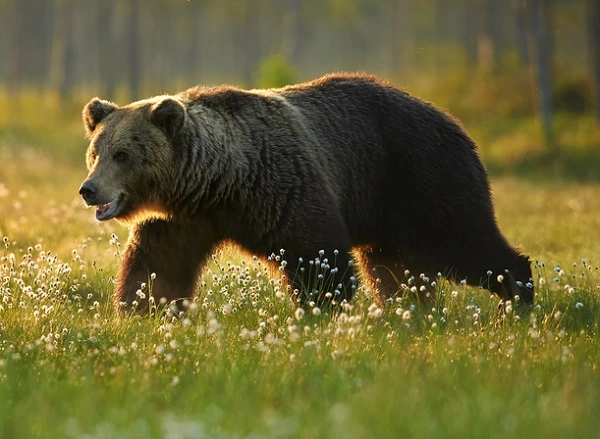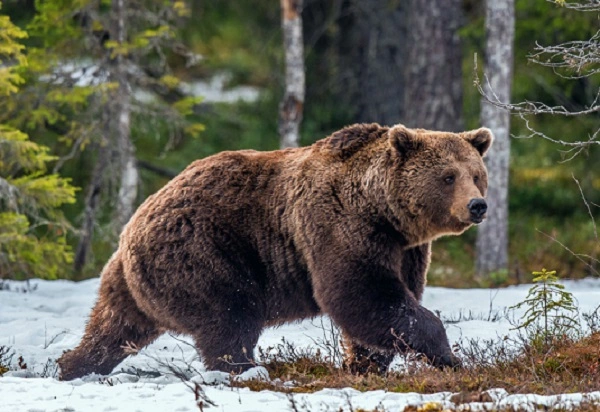Although brown bears are not as commonly seen as their black bear counterparts, they are still widespread and can be found in many different habitats. Brown bears are typically solitary animals, but they will sometimes form small family groups. These bruins feed on a variety of things, including plants, insects, and other small mammals. In this blog post, we will take a closer look at the brown bear and its habits. Stay tuned!

Brown Bear Description
Brown bears are large animals that can weigh up to 600 pounds. They typically have brown fur, although their exact color can vary depending on their location and diet. Brown bears are found in North America, Europe, and Asia, and they tend to inhabit areas with dense vegetation. Brown bears are omnivorous, meaning that they eat both plants and animals. Their diet consists of things like berries, leaves, roots, insects, fish, and small mammals. Brown bears are good swimmers and excellent climbers, and they often build dens in rocky areas or thick forests. Brown bears are generally solitary animals, but they will sometimes travel in groups of two or three. Females usually give birth to two or three cubs at a time. Brown bears are protective of their young and will fight fiercely if necessary to defend them. Brown bears typically live for around 20 years in the wild.
Brown Bear Habitat
Brown bears are found in a wide range of habitats across North America, Europe, and Asia. In general, they prefer areas with dense vegetation and plenty of access to food. Brown bears typically make their dens in caves, hollow logs, or dense brush. They also often build large nests of grass and leaves in which to sleep or rest. Brown bears are excellent swimmers and can often be seen fishing for salmon in rivers or lakes. In addition to their love of water, brown bears also enjoy spending time in trees. They are often seen climbing or feeding on nuts and berries in forested areas. Brown bears are very adaptable creatures and can live in a variety of different habitats. However, they require large areas of land in order to find enough food to sustain themselves. As human populations continue to grow, brown bear habitat is becoming increasingly fragmented and difficult to find.
Brown Bear Diet
Brown bears are found throughout North America, Europe, and Asia. They typically inhabit forested areas, but can also be found in tundra and meadows. Brown bears are opportunistic feeders and their diet varies depending on their location and the time of year. In the spring and summer, they primarily eat plants and berries. During the fall, they consume a lot of nuts and seeds in preparation for winter. In the winter, they largely hibernate but may feed on carrion if they are able to find it. Brown bears have also been known to eat fish, small mammals, and insects. While brown bears are mostly carnivorous, their diet is largely dependent on what is available in their environment.

Brown Bear Size
Brown bears are some of the largest members of the bear family, with males averaging seven feet in length and weighing upwards of 600 pounds. Females are typically smaller, averaging five to six feet in length and 400 to 500 pounds in weight. Brown bears can be found across North America, Europe, and Asia, inhabiting a variety of habitats including forests, mountains, and tundra. Brown bears are omnivorous, feeding on a diet of fish, berries, roots, and small mammals. However, they are most commonly known for their scavenging habits, often stealing kills from other predators such as wolves and coyotes. Brown bears are solitary animals, only coming together during mating season. Females give birth to two to three cubs per litter and remain with them for two to three years before they become independent. Brown bears typically live 15 to 20 years in the wild.
Brown Bear Lifespan
Brown bears typically live between 20 and 30 years in the wild, although some may live even longer. In captivity, brown bears have been known to reach the age of 40 or more. Brown bears are one of the largest land predators, and they play an important role in their ecosystems. Brown bears are found throughout North America, Europe, and Asia. They are highly adaptable and can live in a variety of habitats, from dense forests to open tundra. Brown bears are omnivores and their diet consists of both plant and animal matter. In the spring and summer, they primarily eat vegetation, berries, and roots. In the fall, they switch to a diet of fish and small mammals as they prepare for winter hibernation. Brown bears typically mate every other year, with peak mating season occurring in late June or early July. After a gestation period of about seven months, cubs are born blind and weigh only about one pound each. Cubs stay with their mothers for two to three years before striking out on their own. Brown bears are notoriously elusive creatures, but they are a fascinating species that play an important role in the environment.
Brown Bear Behavior
Brown bears are one of the most widely distributed bears in the world, found throughout North America, Asia, and Europe. They are typically shy and solitary animals but can be aggressive if provoked. Brown bears are excellent climbers and swimmers and have been known to run at speeds of up to 35 miles per hour. Adult brown bears typically weigh between 200 and 600 pounds, with males typically being larger than females. Brown bears live in a variety of habitats, including forests, meadows, and mountainous areas. Their diet consists mainly of plants and berries, but they will also eat fish, insects, and small mammals. Brown bears are active during the day and night, and typically spend several hours each day feeding. While they are generally timid around humans, brown bears can be dangerous if they feel threatened or are protecting their cubs. As a result, it is important to avoid contact with Brown Bears whenever possible.
Brown Bear Speed
Brown bears are the largest land carnivores in North America, and they can run up to 35 miles per hour in short bursts. Brown bears typically weigh between 200 and 600 pounds, but some males can weigh over 1,000 pounds. Brown bears are excellent swimmers and can swim for long distances. They are also good climbers and will often climb trees to escape predators or to get a better view of their surroundings. Brown bears hibernate during the winter months, and their thick fur helps to keep them warm during this time. Brown bears are found in many different habitats across North America including forests, mountains, and wetlands.
Brown Bear Hunting
Brown bears are one of the most popular animals to hunt. They are large and dangerous, which makes them challenging prey. Brown bears are found in many different parts of the world, including North America, Europe, and Asia. In some areas, such as Alaska, brown bear hunting is a very popular sport. There are a few different ways to hunt brown bears. One method is to stalk the bear and then shoot it when it is within range. Another method is to set up a bait station and wait for the bear to come to the bait. Brown bear hunting can be dangerous, so it is important to be prepared before embarking on a hunting trip. Hunting guides can provide valuable information about where to find bears and how to safely hunt them.
Conclusion
Brown Bear is an interesting animal that has many unique features. Although they are not commonly seen in the United States, it is important to be aware of their presence and understand their role in the environment. By educating people about brown bears, we can help create a better understanding and appreciation for these animals. Have you ever seen a brown bear in person? What was your experience like?
Frequently Asked Question

